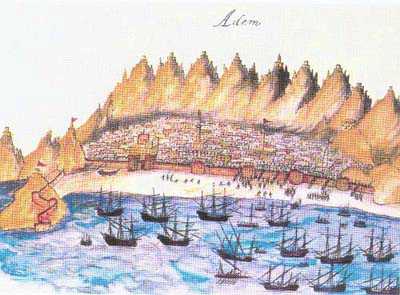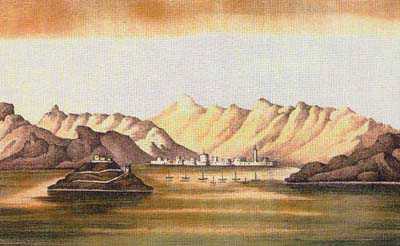

To next page
al Hasan ibn Ali al-Sharif al-Husayni: Mulakhkhas al-Fitan
(book of legal decisions)(d1412) from Aden
-------------------------------------------
Taken from : B.G. Martin African Historical Studies 1974
Medieval Administrative and Fiscal Treatise from the Yemen: G. Rex Smith
...............
Account of the agreed taxes of the felicitous Yemini ports, God perpetuate the rule of their ruler.
.............
Civet, on the ounce 1/12+1/3
Slaves from Aden and its environs, per head two and a half dinars
Merchant ships of Mogadishu-slaves per head 2 1/2
...................
The tax of the blessed tithes at the customs house of the place of entry, Aden the protected-God prolong the rule of her ruler. On all the commodities arriving from India, Iraq, Syria, Egypt, the West and other provinces, Abyssinia and all the lands of the blacks.
.................
Ambergris: every eight mithqal 1/4, 1/6, 1/8, 1/96; bahar (300 mithqal) 20 1/6, 1/4, 1/8; it does not change, but on each mithqal 1/24, 3/96. It arrives by sea from the eastern ports, the weight of the ratl in the tithes at the customs house is 91 mitqals and the weight of the ratl in any purchase...........
Leopard skin: ten 4 1/2, 3/96
..................
Rice weighted in stones was tithed in the year 727 in the vessel of Amir Sharaf al-Din Qasim al-Daybuli in full and completely. This was also tithed in the year 736 (in the vessel of Amir) Nasir al-Din Sharif Musa b. Husayn (arriving) from Kilwa in the stewardship of Qadi Badr al-Din Hasan Said b. Hasan, the district overseer.
.............
Khuri sandalwood, Zanji and Khuri: 1/3, 1/4, 1/48
................
Zanjibari sandarac: bahar 5 2/3
............
Ebony: bahar 1/3, 1/4, 1/8, 3/96
Malindi sandalwood: bahar 1 1/8, 1/48
.............
Dragon's blood: bahar 22 2/3, 1/48
Myrrh and (?) olibanum: bahar 1 3/4, 1/48
...............
Ivory: bahar 6 1/6, 1/8, 1/48
..................
Commodities in bahar from Egypt
..............
Ivory: bahar 5 3/4, 1/48
.......
Court taxes from the whole of northern Tihamah, Zabid, Taizz, al-Samkar, Jiblah, al-Mafalis, Lahej, Abyan, Ahwar, Hawrah, al-Shihr, Zafar, Zayla, Mazunah and all other Eastern Ports.
............
Ivory: bahar 5 3/96, 1/48
...........
Dragon's blood: bahar 20
.............
(The taxes places upon) commodities arriving from eastern ports, from Qays, Hurmuz, Qalhat, Zafar, al-Shihr, Kharj, Mogadishu, Zayla, Tajrah, M.r.u.ah, al-Sharjah, al-Hadith, al-Hirdah, al-Ahwab and Haly Ibn Yaqub etc....
Aloes: ten mann 1 1/4, 1/8
..........
Waistwrappers of mixed material and with a selvage and linen with a selvage from Mogadishu and elsewhere (linen with a selvage is taxed in the same way): ten 3 1/12
.............
Cotton nut-coloured garments with selvage from al-Shihr, Mogadishu, Zafar and Syria: one 1/4, 1/8, ten 3 3/4.
Cotton towels and those with a selvage from the areas mentioned above the same, (and those from) Zabid and Northern Tihamah: one 1/6, 1/8, 1/48
....................
(?) veil, aloes, ivory, wax and calomel; there is less (tax to be paid) for (each) according to the amount of time (spent) in examining it.
Cinnabar, a tenth; galingale, a tenth; local aloes, a fifth; ivory, (amount calculated) according to (the time spent) examining (it), whatever the weighter says in accordance with the demands of what is exported.
Concerning each peace: 800 700 600 500 400 300, 15 10; 295, 5; 90 150, 3; 95 55, 2 ratl; 50, 1 ratl
..................
When commodities come from Zayla, East Africa, Aydhab etc... when there is something made of leather there can be no payment on them other then one tenth-nothing else.
..................
Shaykh Kamal al-Din al-Maqdashi arrived from Mogadishu in 751 (begins 11 March 1350) b.trar y. his ship a chest made of leather (and) there was no payment imposed upon him other then one tenth. Also inside where some cowries covered in leather, but the only payment was one tenth, nothing else.
Exports
.................
Ivory by the piece: 800 700 600 500 400, 15; 300 295 250,10; 250 230 200, 5; 195 150 100,3 (between) 95 (and) 50,2 ratl; 5, 1 ratl
..................
When Somali sheep arrive from east and west, they are put in a pen, just below the customs house. The deputy of the government bureau and the secretaries of the trading establishment come and fix the share of the felicitous bureau, the share of the bureau being their choice. (The sheep) remain standing and are brought out one by one so that they do not get injured.
Guy Ducatez et �ric Vallet have mentioned on a website, (based on the Mulakhkhas): Jurisconsults (Qadis) from Mogadishu were strongly involved in the trade of books and slaves to local counterparts in Aden (it is unknown if they were closely connected ones, like family or just allies) This statement is based on the chest of leather found in the possession of the Mogadishu shaykh.
Taken from: The miniature painting and painters of Persia, India, Turkey (p105)
Ali Efendi; the author of Manaqib-i-Hunarvaran who wrote at the end of the 16th century:
The Habashi and Dimashqi (Damascus) papers are worthless; no paper should be employed that is inferior in quality to that of Samarqand.
(As the Arabs were fighting the holy war to the Ethiopians at the time this got written Habashi can not have meant Christian Ethiopia but what is now Somalia.)